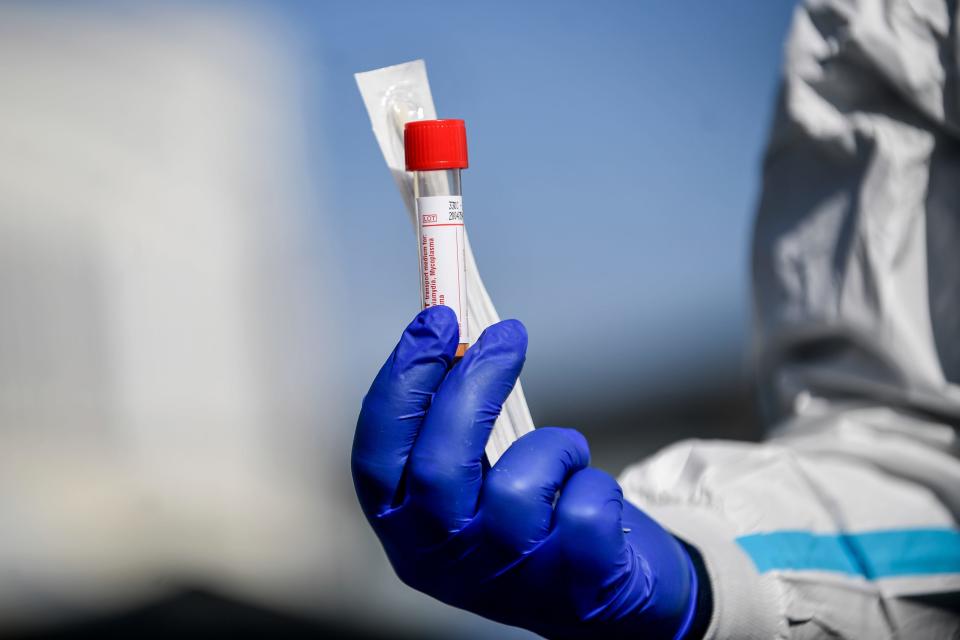'The epidemic is out of control, yet that doesn't mean we should give up': The US must keep expanding coronavirus testing, even though it missed the critical window

Claudio Furlan/LaPresse via AP
The US missed its chance to contain the coronavirus by not testing enough people early on.
Widespread testing in Iceland, South Korea, Germany, and Singapore, by comparison, helped those countries prevent larger outbreaks.
Testing per capita in the US still lags behind, with doctors and hospitals continuing to report shortages. That means experts don't have an accurate picture of the country's epidemic.
But the country needs to test as widely as possible, not just to isolate and treat those who are sick, but also to find people who have recovered and may have developed immunity.
The US's high coronavirus case load — more than 277,000 Americans have gotten it, and that's just those who've been tested — shows the country missed its chance to contain the outbreak.
Many experts say that's in large part due to failures to test widely and isolate infected people early in the virus' spread.
The US's testing has ramped up considerably — more than 1.4 million people have now been tested, up from just 135,000 on March 20.
But William Schaffner, a professor of preventive medicine at Vanderbilt University, told USA Today that the US's testing expansion is "not as if it's a train running along, as you might've heard, because testing is restricted still in many parts of the country."
But Quest Diagnostics, one of the US's biggest testing companies, has said it has a major backlog. And test distribution is still uneven.
"Unless you are hospitalized and a diagnosis will impact your care, you will not be tested," New York City's health department says.
Extensive testing is still a crucial step in getting through this crisis, however.
"In the US, we've got a problem because we were slow to roll out testing and the epidemic is out of control, yet that doesn't mean we should give up," Dr. Steffanie Strathdee, associate dean of global health sciences at the University of California San Diego, told Business Insider.
World Health Organization Director General Tedros Adhanom Ghebreyesus put the point more bluntly last month: "You cannot fight a fire blindfolded, and we cannot stop this pandemic if we don't know who is infected," he said. "We have a simple message for all countries: Test, test, test, every suspected case."
Evolving reasons for testing
Strathdee added that the reasons why — and how — a country should test for COVID-19 are evolving as time passes and outbreaks grow.
"At the very early stages of this epidemic, we're testing so that we can help prevent the spread in the population," Strathdee said. It's too late for that to be effective in containing the US's outbreak as a whole, but countries that did test widely early on, like South Korea, Germany, and Singapore, developed a clearer picture of where the disease was spreading. That enabled them to more precisely target their public-health strategies.
Along with surveillance efforts, strict quarantines, and social-distancing measures, those testing efforts helped the countries better control their outbreaks.
Iceland's government has said that anyone who wants to can get tested, allowing officials to quickly isolate people who test positive. That has led to a higher number of cases per capita — 0.36% of Icelanders have been diagnosed with COVID-19 compared with around 0.08% of Americans — but Iceland has tested nearly 6% of its population while the US is at approximately 0.43%.
"We really have no upper limit on the amount of tests we want to do," Kjartan Hreinn Njálsson, assistant to the director of health of Iceland's Directorate of Health, told Business Insider. "The screening program in Iceland has helped us in estimating the prevalence of the virus in the general population, and that data has informed our model-making and risk-management."
Some US states are just beginning to see cases rise, so they may still be able to identify and isolate people, Strathdee said. She added that widespread testing efforts must also seek out and include people in vulnerable populations, such as undocumented immigrants, homeless, and incarcerated individuals. These people may be infected but unable to seek medical care.
"If we leave a segment of the population behind, that's going to put everybody at risk," Strathdee said.
The ability to monitor herd immunity
For places that have already become hotspots, like New York and Washington, the goal of testing has changed.
"Another reason that you want to be able to test is to establish and to monitor herd immunity over time," Strathdee said.
Experts aren't sure whether people who get the coronavirus are fully or permanently immune after recovering, but Anthony Fauci, director of the National Institute of Allergy and Infectious Diseases, has said he's "willing to bet anything that people who recover are really protected against re-infection."
In order to figure out who has developed immunity, the US must conduct a new kind of test, a different type than the diagnostic tests used now. Serology, or antibody, tests can detect whether a person has already had COVID-19, regardless of whether they showed symptoms, by identifying antibodies in their blood. A positive result would mean they're probably immune.
Robert Redfield, director of the Centers for Disease Control and Prevention, has estimated that up to 25% of people infected with the virus showing no symptoms at all. That would make antibody tests another essential tool in the US's fight against the coronavirus.
Read the original article on Business Insider

 money
money 